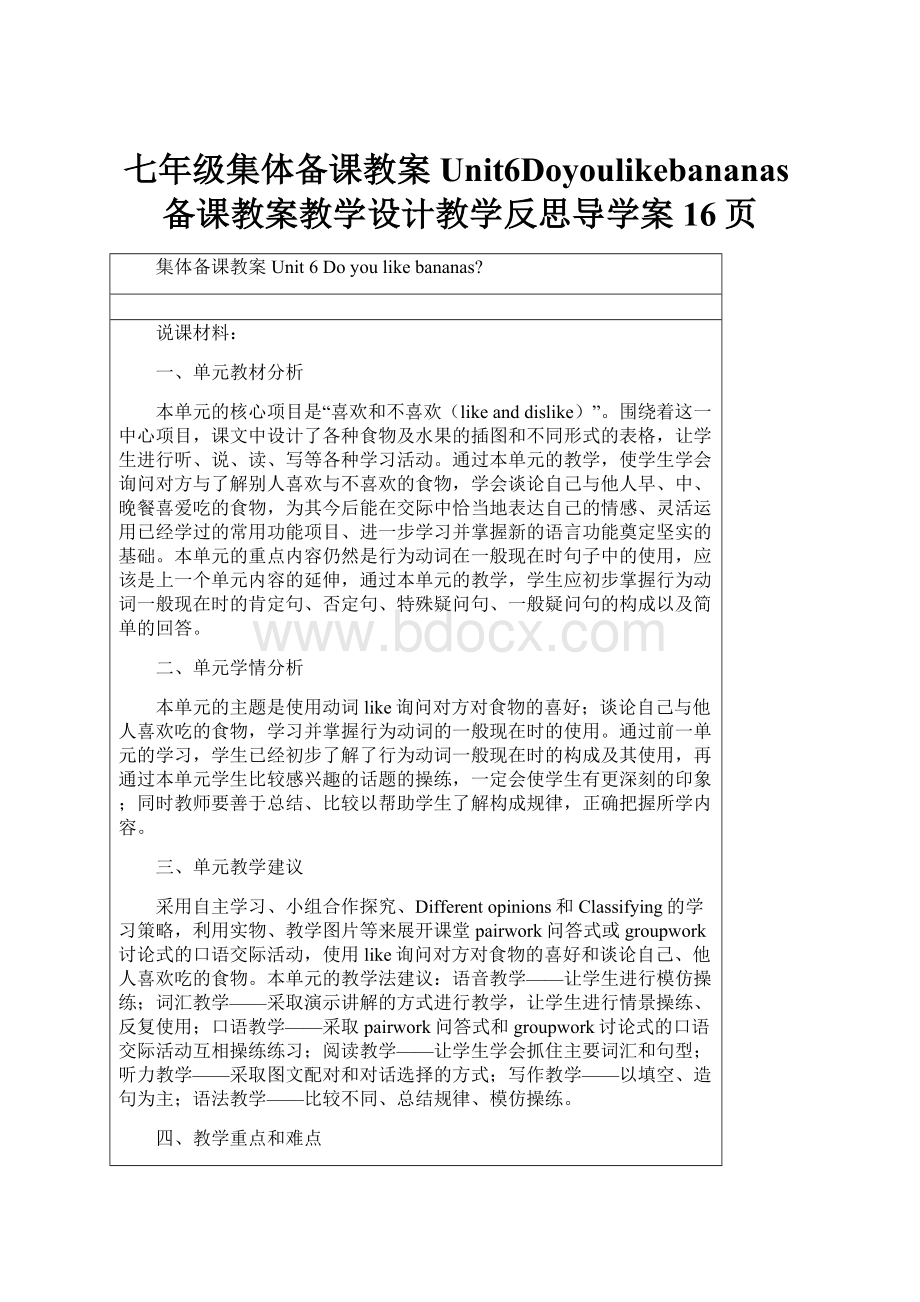七年级集体备课教案Unit6Doyoulikebananas备课教案教学设计教学反思导学案16页.docx
《七年级集体备课教案Unit6Doyoulikebananas备课教案教学设计教学反思导学案16页.docx》由会员分享,可在线阅读,更多相关《七年级集体备课教案Unit6Doyoulikebananas备课教案教学设计教学反思导学案16页.docx(22页珍藏版)》请在冰豆网上搜索。

七年级集体备课教案Unit6Doyoulikebananas备课教案教学设计教学反思导学案16页
集体备课教案Unit6Doyoulikebananas?
说课材料:
一、单元教材分析
本单元的核心项目是“喜欢和不喜欢(likeanddislike)”。
围绕着这一中心项目,课文中设计了各种食物及水果的插图和不同形式的表格,让学生进行听、说、读、写等各种学习活动。
通过本单元的教学,使学生学会询问对方与了解别人喜欢与不喜欢的食物,学会谈论自己与他人早、中、晚餐喜爱吃的食物,为其今后能在交际中恰当地表达自己的情感、灵活运用已经学过的常用功能项目、进一步学习并掌握新的语言功能奠定坚实的基础。
本单元的重点内容仍然是行为动词在一般现在时句子中的使用,应该是上一个单元内容的延伸,通过本单元的教学,学生应初步掌握行为动词一般现在时的肯定句、否定句、特殊疑问句、一般疑问句的构成以及简单的回答。
二、单元学情分析
本单元的主题是使用动词like询问对方对食物的喜好;谈论自己与他人喜欢吃的食物,学习并掌握行为动词的一般现在时的使用。
通过前一单元的学习,学生已经初步了解了行为动词一般现在时的构成及其使用,再通过本单元学生比较感兴趣的话题的操练,一定会使学生有更深刻的印象;同时教师要善于总结、比较以帮助学生了解构成规律,正确把握所学内容。
三、单元教学建议
采用自主学习、小组合作探究、Differentopinions和Classifying的学习策略,利用实物、教学图片等来展开课堂pairwork问答式或groupwork讨论式的口语交际活动,使用like询问对方对食物的喜好和谈论自己、他人喜欢吃的食物。
本单元的教学法建议:
语音教学——让学生进行模仿操练;词汇教学——采取演示讲解的方式进行教学,让学生进行情景操练、反复使用;口语教学——采取pairwork问答式和groupwork讨论式的口语交际活动互相操练练习;阅读教学——让学生学会抓住主要词汇和句型;听力教学——采取图文配对和对话选择的方式;写作教学——以填空、造句为主;语法教学——比较不同、总结规律、模仿操练。
四、教学重点和难点
教学重点:
1、掌握关于食物的词汇。
2、熟练运用所学功能项目谈论喜好和厌恶。
3、能准确地用英语描述一日三餐的食谱。
教学难点:
1、交际用语Doyoulikebananas?
Yes,Ido./No,Idon’t.
2、描述一日三餐的方法。
3、一般现在时,主语是三单时,助动词与动词的变化。
4、可数名词和不可数名词的区别。
五、教学方法和学习策略
1、教法
(1)本单元话题源自生活,立足这一点,充分利用学生已有的知识和经验,创设生活化的真实(或半真实情景)引导学生在运用语言中学习语言,然后在学习新的语言知识后创造性地运用语言(为用而学,在用中学,学了用)。
(2)开展多种类型任务活动,提供给学生合作交流的空间和时间,促使学生为完成任务和同学进行合作,为完成任务进行探究学习。
2、学习策略:
(1)通过Disscussing,ClassifyingandGuessing等形式多样的活动,促使学生运用认知策略进行有效地学习。
(2)在与同学合作完成任务的活动中主动探究和学习语言;并运用知识内在规律帮助记忆、巩固知识。
六、单元课时分配
本单元可用六课时完成教学任务:
SectionA(1a-1d)用1课时
SectionAl(2a-2d)用1课时
SectionA(GrammarFocus-3c)用1课时
SectionB(1a-1e)用1课时
SectionB(2a-2c)用1课时
SectionB(3a-Selfcheck)用1课时
七、教学过程设计:
TheFirstPeriod
Ⅰ.TeachingAimsandDemands
1.KnowledgeObjects
Keyvocabulary:
hamburgers,tomatoes,broccoli,Frenchfries,oranges,icecream,salad,bananas,strawberries
Targetlanguage:
Doyoulikebananas?
Yes,Ido.
Doyoulikesalad?
No,Idon’t.
2.AbilityObjects:
Trainstudents’listeningskill.
Trainstudents’communicativecompetenceusingthekeyvocabularyandthetargetlanguage.
3.MoralObjects:
Nomatterwhatfoodyoulikeordon’tlike,youshouldeatsomethinghealthy.
Ⅱ.TeachingKeyPoints
Thenamesoffood.Askandanswerquestionsaboutlikesanddislikes.
Ⅲ.TeachingDifficultPoints
Usethekeyvocabularyandthetargetlanguagelearnedinthisclasstodescribesituationsinone’sownlives.
Ⅳ.TeachingMethods
Sceneteachingmethod.Pairwork.
Ⅴ.TeachingAids
Ataperecorder./Picturesoffoods.
Ⅵ.TeachingProcedures
SectionA
StepⅠKeyVocabulary
Usingpicturesoffoods,teachandpracticehamburgers,tomatoesandbroccoli.Putthepicturesupontheblackboardwithitsnameunderneathonenexttoanother.UsethesameapproachtoteachandpractiseFrenchfries,oranges,icecream,salad,bananasandstrawberries.Removethepictures,writethefoodnamesinadifferentorderfrombefore,thenhandthepicturestodifferentstudentsandaskthestudentsmatchthemwiththerightwords.Therestofclasswatchandchecktheiranswers.
(Thisactivityintroducesthekeyvocabulary.)
StepⅡ1a
Askamoreadvancedstudenttosaythewordsinthelistandhavestudentsrepeat.
Callstudentsattentiontothepicturesandask.
T:
Whatcanyousee?
Canyouseehamburgers?
Ss:
Yes,Ican.
Pointoutthesampleanswerandsaydiswrittenontheblanklineafterthewordhamburgers.Nowyouareaskedtomatchtheotherwordswiththepictures.
Studentsworkontheirown.
Correcttheanswers.
Answers:
1.hamburgersd
2.tomatoesg
3.broccolia
4.Frenchfriesh
5.orangee
6.icecreamf
7.saladc
8.bananasb
9.strawberriesi
10.pears
(Thisactivityintroducesthekeyvocabulary.)
StepⅢ1b
Pointouttheboxeswherestudentswillwriteanumberforeachconversation.Thefirstoneisdoneforyou.
Playtherecordingforthefirsttime.Studentsonlylisten.
Playtherecordingagain.Thistimestudentslistenandnumbertheconversations1-3.
Checktheanswers.
Answers(fromlefttoright):
2,1,3
Tapescript:
Conversation1:
Boy:
Doyoulikebananas?
Girl:
Yes,Ido.
Conversation2:
Girl:
Doyoulikesalad?
Girl:
No,Idon’t.
Conversation3:
Girl:
Doyoulikeoranges?
Boy:
Yes,Ido.
(Thisactivityintroducesthetargetlanguage.)
StepⅣ1c
SaytheconversationsinActivity1bandhavestudentsrepeat.
Writethemontheblackboard.
Thenstudentspractisetheconversationsinpairs.Dealwithanyproblemsthestudentsraisewhilepractising.
Pointtothefirstwordontheblackboard.Demonstrateanewconversationwithastudent,substitutingthewordhamburgersintoconversation1.
Repeatthesameapproachwithconversation2.
T:
Doyoulikehamburgers?
S1:
No,Idon’t.
T:
Doyouliketomatoes?
S2:
Yes,Ido.
Studentsworkinpairs.MaketheirownconversationsusingthenamesoffoodslistedinActivity1a.
(Thisactivityprovidesstudentsoralpracticeusingthekeyvocabularyandthetargetlanguage.)
OptionalActivity:
AskstudentstodrawpicturesofthefoodswhichtheylearnedinActivity1a.EncouragestudentstodrawsomeextrapicturesoffoodswhosenametheyknowinEnglish.Thenstudentsmakeconversationsinpairsusingthefoodsinthepicturesascues.Afewminuteslater,askeachpersontofindanewpartnerandcontinuethepractice.Inthisway,everypersonhastheopportunitytoaskandanswerquestions.
(Thisactivitygivesstudentsafurtherpracticewiththekeyvocabularyandthetargetlanguage.)
StepⅤSummary
Inthisclass,we’velearnedthenamesoffoodsandpractisedaskingandansweringquestionsaboutlikesanddislikes.
StepⅥHomework
Afterclass,everystudentmakesmoreconversationswithhis/herpartnerandrecordstheirconversations.
TheSecondPeriod
Ⅰ.TeachingAimsandDemands
1.KnowledgeObjects:
Listenandwritethekeyvocabulary.GrammarFocus.
2.AbilityObjects:
Trainstudents’listeningskill.Trainstudents’writingskill.
3.MoralObjects
InChina,it’simpoliteforyoutoacceptfoodthefirsttimeitisoffered.ButinAmerica,ifyousay“no”thefirsttimethehostoffersyousomethingtoeat,thehostmaythinkthatyoureallydon’twantthefood.Soyou’dbetterknowsomecultureaboutthecountrywhenlearningaforeignlanguage.Languageiscloselyassociatedwithit.
Ⅱ.TeachingKeyPoints
Targetlanguage:
1.Doyoulikesalad?
Yes,Ido./No,Idon’t.
2.Doeshelikesalad?
Yes,hedoes./No,hedoesn’t.
3.Ilikeoranges.4.Helikesoranges.5.Idon’tlikeoranges.6.Hedoesn’tlikeoranges.
Ⅲ.TeachingDifficultPoints
PresentTensetolikeincludingyes/noquestionsandaffirmativeandnegativestatements.
Ⅳ.TeachingMethods:
Pairwork./Summarization.
Ⅴ.TeachingAid:
Ataperecorder.
Ⅵ.TeachingProcedures
StepⅠ
Askdifferentstudentstoplaytheirrecordingfortheclass.Givepraisetothosewhosepronunciationandintonationarebothexcellent.
StepⅡ2a
Saythewordsintheboxandhavestudentsrepeat.Theninviteamoreadvancedstudenttosaythemandhavetheotherstudentsrepeat.
Youwilllistentothreeconversationsandcirclethenamesoffoodsyouhear.Pointoutthesampleanswer.
Playtherecordingforthefirsttime.Studentsonlylisten.
Playtherecordingforasecondtime.Thistimestudentslistenandcirclethefoodstheyhear.
Checktheanswers.
Answers:
circledwords:
hamburgersbroccoliicecream
Tapescript:
Conversation1:
Girl:
Ilikehamburgers.Doyoulikehamburgers?
Boy:
Yes,Ido.
Conversation2:
Girl:
Doyoulikebroccoli?
Boy:
No,Idon’tlikebroccoli.
Conversation3:
Girl:
Let’shaveicecream.Boy:
Oh,no.
Girl:
No?
Boy:
Idon’tlikeicecream.
(Thisactivityprovidespracticerecognizingthekeyvocabularyinspokenconversations.)
StepⅢ2b
Callstudents’attentiontothecartoonstory.Saytheconversationsinthespeechbubblesaloud,sayingblankeachtimeyoucometoanemptywrite-online.
Youaretofillinthemissingwordswhilelisteningtothetape.
Playtherecordingtwice.Studentslistenandwritethecorrectwordsontheblanks.
Correcttheanswers.
Answers:
1.hamburgers2.hamburgers3.broccoli4.broccoli5.icecream6.icecream
StepⅣ2c
SaytheconversationinspeechbubblesinActivity2bandhavestudentsrepeat.Thenstudentspractiseitinpairs.
Askstudentswhatkindoffoodtheylike?
Whatkindoffoodtheydon’tlike?
Maketwolistsontheblackboardunderheadlineslikeanddon’tlike.Itdoesn’tmatterthatsomefoodsmayappearonbothlists.
SaythreenewconversationswithdifferentstudentsusingfoodslistedontheblackboardinplaceoftheunderlinedwordsinthespeechbubblesinActivity2b.
Studentsthenpractisetheconversationsinpairs.Remindstudentstogiveanswersthataretrueforhimself/herself.Astheypractise,movearoundtheclassroomcheckingprogressandofferingpronunciationandintonationsupportasneeded.
Invitepairsofstudentstoactouttheirconversationsfortheclass.
(Thistaskgivesstudentsanopportunitytopractisethetargetlanguage.)
StepⅤGrammarFocus
Askdifferentstudentstosaythequestionsandanswerstheaffirmativeandnegativestatements.Thefollowingarenoteworthy.
(1)Thewordsdo,does,don’tanddoesn’tarestressedwhensayingtheshortanswers.
(2)Thethirdpersonsingularformsallcontainans.Itsmainverbislikes.Itshelpingverbsaredoesanddoesn’t.
Writesomeexamplesentencesontheblackboard.
NowaskstudentstolookattheCountablenouns,uncountablenouns,andcountableanduncountablenounscolumns.Havethreestudentsreadthewordsineachcolumn.Tellstudentsthatcountablenounscanbecountedwithnumbers,andweadd-sor-estomaketheplural.Forexample,wesayatomatoandtwotomatoes.Uncountablenounscan’tbecountedwithnumbersandtheydon’thaveplurals.Forexample,broccoli,However,somewordscanbeeithercountableoruncountablenouns.Forexample,salad.Encouragestudentstoaddmorefoodstoeachcolumn.
(Thisactivitygivesstudentsafurtherunderstandingofthetargetlanguage.)
StepⅥSummary
In